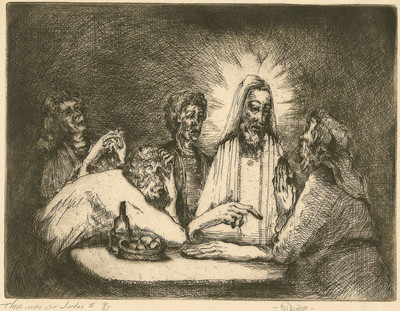
Karnig Nalbandian
There Was No Judas II
Etching, aquatint
Once the very byword for infamy, treachery, and betrayal, Judas has undergone a radical reappraisal in the modern era. The recent rediscovery of The Gospel of Judas, an obscure 2nd-3rd Century gnostic text, portraying Judas as the only disciple who really understood Christ, has been heralded in the mass media as a find all but rivaling the discovery of the Dead Sea Scrolls. TV and movie scriptwriters present the disciple-gone-wrong as a sympathetic character, a disillusioned idealist who discovers too late the shabby role he must play in the Passion Drama. Graphic Artist Karnig Nalbandian captures something of our contemporary ambiguity about the betrayer of Christ in an etching, intriguingly titled, There Was No Judas II (apparently, the second print he made on this theme.) In Nalbandian’s recasting of traditional Last Supper imagery, Christ has just informed his disciples that one of them will betray him. This time, there is no Judas at the table to receive the bread dipped in sauce from Jesus and be marked as the man who will set in motion the events leading to the Crucifixion. Sadly, assigning guilt for the “killing of Christ” churns like a deep, dark current through the history of the Church, as if making Judas, the Jews, or anyone else the scapegoat for what happened on Good Friday somehow absolves the rest of humanity from responsibility in Christ's sacrificial death. Looking at this unconventional little print reminds me I am just as much a participant in the story of redemption, as if I had been in Jerusalem on Holy Week. If the finger gets pointed at anyone--it ought to be me and you and all the rest of us.
